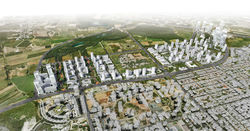STRUCTURE STUDIO
(T) +972.3.6209206
F) +972.153.3.6209206
RUHAMA 8 | TEL AVIV -JAFFA | ISRAEL
סטודיו סטרוקטורה
(ט)03.6209206
(פ)153.3.6209206
רוחמה 8 | תל אביב יפו | ישראל
 |  |  |  |  |  |  |
|---|---|---|---|---|---|---|
 |  |
East Rehovot Neighborhood Urban nature
Typology City Building Plan Landscape design
Location of East Rehovot Israel
Area 300 dunams
Urban construction: Yasky Moore Sivan Architects
The landscape concept defines the interplay between human culture and nature on three scales
Urban landscape unit - the scenic area of the east of the city is not a submerged area of Rasa, but is planted with many historical and scenic points of interest - the municipal cemetery along the axis of Gorodetsky St., Ahuzat Caspi, the historic guard tower, Pardes and Beer House, packing house and winter pool These weave the historical and cultural story of the city of the orchards and invite a broader look at the planning of the neighborhood. Therefore, we propose to read the new neighborhood as one of four longitudinal strips (north to south), which gradually form the relationship between the development of the new neighborhood and the nature reserve, from west to east respectively:
Development strip for residential, employment and commercial and public buildings, according to the program. In the center is the municipal cemetery.
Future residential development strip (according to the outline plan). This strip includes the future water reservoir that will improve water flow to the eastern neighborhood of the city during the hot season.
Extensive park strip - development of a park as a scenic complex that unites parts of the neighborhood. The orchard house and the well and the historic packing house will serve as historical activity centers for the residents of the city. The neglected watchtower, which has an impressive architectural appearance, will serve as an impressive vantage point over the entire space and the biodiversity that lives in it.
An analysis of the elevation map invites the expansion of the winter pool into a linear lake along the park. The lake will enrich the quality of life of the residents of the new neighborhood and the residents of the entire city. In addition, the lake will serve as a pool for collecting and collecting runoff water, and as a source of life that will enrich the plant and biodiversity beyond the winter months in which the existing winter pool is active. At points of interest along it, grove trees will be planted for shading and habitats for species living in the area.
The nature reserve strip and the winter pool, up to the eastern border of the city.
On the longitudinal strips, four green fingers are proposed from east to west which connect the new neighborhood to the city to the west, and to the open spaces to the east. The short walking distances in the green fingers (c. 500 m), and between the points of interest in the scenic area to the east, will encourage walking (a few minutes between centers). All into an active and well-connected urban and scenic space. In addition, the scenic strips will be used to collect, collect and drain surface runoff water, which flows from east to west of the city.
Community Landscape Unit - Along with a rich variety of architectural typologies and mixed uses, the urban landscape will serve as a tool for creating diversity, identity and community. Each of the four green fingers will be distinct in its scenic characteristics and will include a unique variety of vegetation, lawns, walking / running trails and bicycles, programs in a variety of uses and ages, proximity to specific public buildings (sports / culture / schools, etc.) and community gardening. Planting many mature trees along each “finger” will create a shaded space and reduce the urban heat islands. The paths from east to west will be used to drain the surface runoff water. As a tribute to the history of the place, we offer to plant an "orchard garden" at the meetings of each landscape unit with the streets from north to south, a scenic show of citrus trees that will connect the four landscape units from north to south. Similar to the extensive park as a unifying factor between parts of the neighborhood on an urban scale, the central finger functions as a rich green lung that defines and connects the residential units that divide it.
Landscape unit The residential block - As a direct continuation of the scenic and social structure of the entire neighborhood, we propose to treat each of the residential buildings as a landscape unit that usually consists of a pair of buildings that create a more common and intimate pocket garden. A soft array of paths connects all the entrances to a small plaza. A separation strip at a depth of c. 10 m will allow a buffer between the garden apartments on the ground floor and a central lawn.
The cemetery when Z.P.
The land section of the cemetery, about 300 dunams, separates the development of parts of the neighborhood from the north and south. The orchard and the cemetery, both landscape forms from human culture that deal with the cycle of life: flowering, fruit and fall in a tree orchard, opposite - birth, maturation, and death in a person's life.
In the connection between the two typologies, we propose to fold the land around the cemetery into a perimeter garden planted with citrus trees and allow the land to be duplicated for burial below it. Thus, at a front c. 1,000 m long around the cemetery, a pedestrian will encounter not a wall but a planted garden. The move will turn the cemetery into a scenic space that does not separate but connects parts of the neighborhood through a garden around it.
